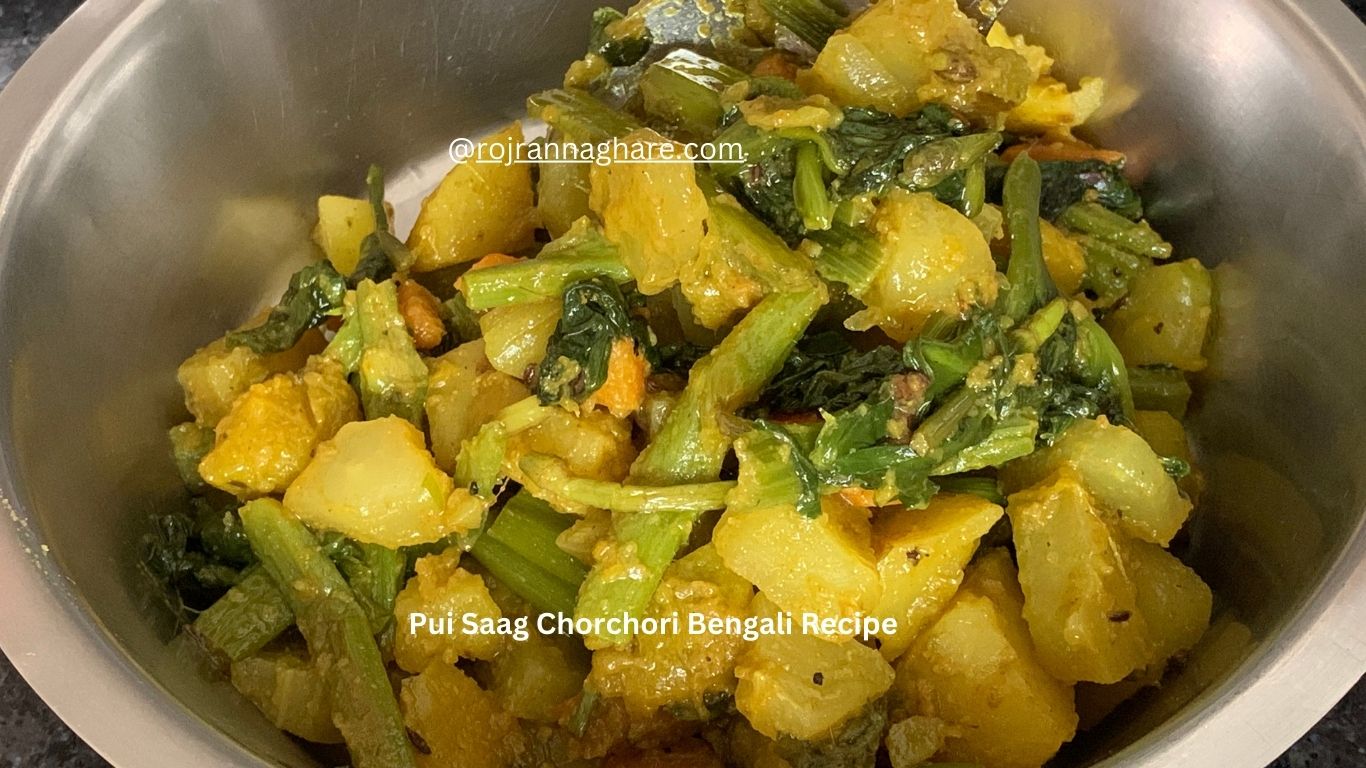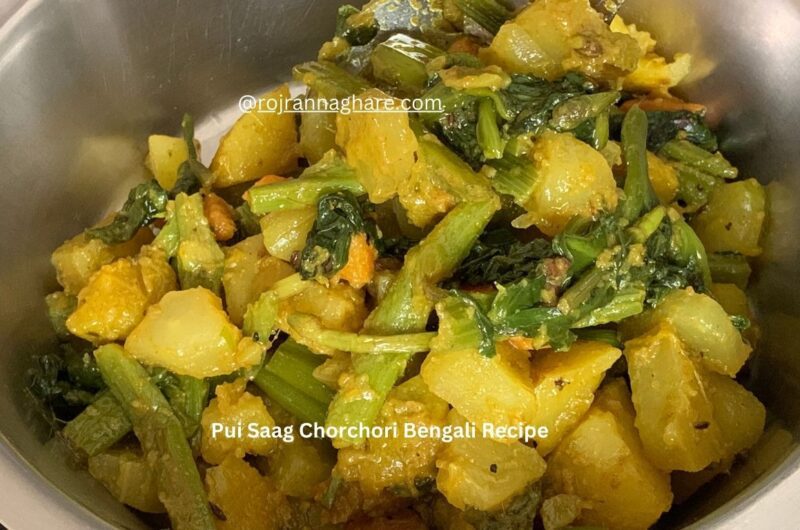Bengali cuisine is renowned for its lavish palette of flavours, providing both vegetarian and non-vegetarian dishes that genuinely captivate the palate. “A culinary jewel of Bengali cuisine, Pui Saag Chorchori is made with Malabar spinach leaves or Basella Alba leaves. This meal is a cherished addition to Bengali cuisine because it is a testament to both flavour and healthiness. We’ll walk you through making the delicious Pui Saag Chorchori in traditional Bengali style in this blog post while also exploring its culinary importance.
Table of Contents
TogglePui Saag Chorchori: A Culinary Tradition:
Pui Saag Chorchori is a classic Bengali dish that perfectly combines the earthy flavour of Malabar spinach with a complex spice mix. This delectable dish is a popular choice for lunch and dinner and is typically served with steamed rice or roti. In addition to its mouthwatering taste, this dish is praised for its superior nutritional value. Malabar spinach adds a healthy depth to your meal experience because it bursts with vitamins, minerals, and nutritional fibre.
Pui Saag Chorchori Ingredients:
Here are the ingredients required to prepare Pui Saag Chorchori Bengali style:
- 250 grams of Pui Saag (Malabar spinach)
- 500g mixed vegetables include potato, pumpkin, papaya, pointed gourd, and carrot.
- 3 tablespoons of mustard oil
- 1 tablespoon of panch phoron
- 2 dry red chilli
- 1 bay leaf
- 1 teaspoon of ginger- 2 green chilli paste
- 1 teaspoon of turmeric powder
- 1 teaspoon of cumin powder
- 1 teaspoon of coriander powder
- Salt to taste
- 1/2 teaspoon of sugar (optional)
- Water as needed
Pui Saag Chorchori Instructions:
1. Start by washing the Malabar spinach leaves thoroughly under running water. Separate the stems into small pieces and chop the leaves into bite-sized pieces. Cut potato, papaya, carrot, pumpkin, and pointed gourd. You can add any vegetables of your choice.
2. In a deep pan, heat the mustard oil until it begins to smoke slightly. This enhances the flavor. Reduce the heat to medium and add the dry red chilli, bay leaf, and panch phoron. Wait for them to splutter. Add ginger-green chilli paste.
3. Add potato, papaya, carrot, and pointed gourd and pui Saager data/stem of the Malabar spinach. Don’t add all the vegetables at the same time.
4. Add salt to taste and Saute for a few minutes. Cover the kadhai and let them turn soft.
5. Now, add pumpkin pieces. Carefully add the chopped Malabar spinach leaves. Stir-fry them for a couple of minutes until they begin to wilt.
6. Lower the heat and add the turmeric powder, cumin powder, and coriander powder. Stir well to combine the spices with the tempering. combine and cook for 7-8 minutes
7. If you prefer a slightly sweet taste, you can also add half a teaspoon of sugar at this stage. Stir well.
8. Let the Pui Saag cook over low to medium heat. Stir occasionally and add a little water if needed to prevent sticking. Cook until the leaves are tender and cooked through.
9. Once the Pui Saag is cooked, remove it from the heat.
Serving Suggestions:
Serve this delicious Pui Saag Chorchori with hot steamed rice or roti for a complete Bengali meal experience. The combination of the mildly spiced Malabar spinach with the earthy flavors of mustard oil is sure to win hearts and palates.
FAQ On Pui Saag Chorchori:
Q. What is Pui Saag Chorchori?
A: Pui Saag Chorchori is a traditional Bengali niramish (vegetarian) dish made from Malabar spinach leaves and its steam. It’s a simple stir-fry that combines Pui Saag with various aromatic spices and vegetables.
A. Why is this dish popular in Bengali food culture?
A: Pui Saag Chorchori holds a special place in Bengali cuisine, especially during the monsoon season. It’s a quick and easy recipe that celebrates the flavours of fresh, seasonal vegetables. The dish is a testament to Bengali culinary tradition and emphasizes the use of regional ingredients.
3. What are the key ingredients for making Pui Saag Chorchori?
A: The main ingredients for this dish are Pui Saag (Malabar spinach), mustard oil, mustard seeds, turmeric, green chillies, ginger, and a mix of various vegetables like pumpkin, potatoes, and brinjal (eggplant). The use of panch phoron (a blend of five spices) is also common for added flavour.
Related Post:
Pui Saag Chorchori | Malabar Spinach | Easy Niramish Pui Shak Recipe Bengali Style
Course: Side dishCuisine: Bengali cuisine4
servings15
minutes25
minutes100
kcalIngredients
250 grams of Pui Saag (Malabar spinach)
500g mixed vegetables include potato, pumpkin, papaya, pointed gourd, and carrot.
3 tablespoons of mustard oil
1 tablespoon of panch phoron
2 dry red chilli
1 bay leaf
1 teaspoon of ginger-2 green chilli paste
1 teaspoon of turmeric powder
1 teaspoon of cumin powder
1 teaspoon of coriander powder
Salt to taste
1/2 teaspoon of sugar (optional)
Water as needed
Directions
Start by washing the Pui Saag / Malabar spinach leaves thoroughly under running water. Separate the stems into small pieces and chop the leaves into bite-sized pieces. Cut potato, papaya, carrot, pumpkin, and pointed gourd. You can add any vegetables of your choice.
In a deep pan, heat the mustard oil until it begins to smoke slightly. This enhances the flavor. Reduce the heat to medium and add the dry red chilli, bay leaf, and panch phoron. Wait for them to splutter. Add ginger-green chilli paste.
Add potato, papaya, carrot, and pointed gourd and pui Saager data/stem of the Malabar spinach. Don't add all the vegetables at the same time.
Add salt to taste and Saute for a few minutes. Cover the kadhai and let them turn soft.
Now, add pumpkin pieces. Carefully add the chopped Malabar spinach leaves. Stir-fry them for a couple of minutes until they begin to wilt.
Lower the heat and add the turmeric powder, cumin powder, and coriander powder. Stir well to combine the spices with the tempering. combine and cook for 7-8 minutes
If you prefer a slightly sweet taste, you can also add half a teaspoon of sugar at this stage. Stir well.
Let the Pui Saag cook over low to medium heat. Stir occasionally and add a little water if needed to prevent sticking. Cook until the leaves are tender and cooked through.
Once the Pui Saag is cooked, remove it from the heat.


